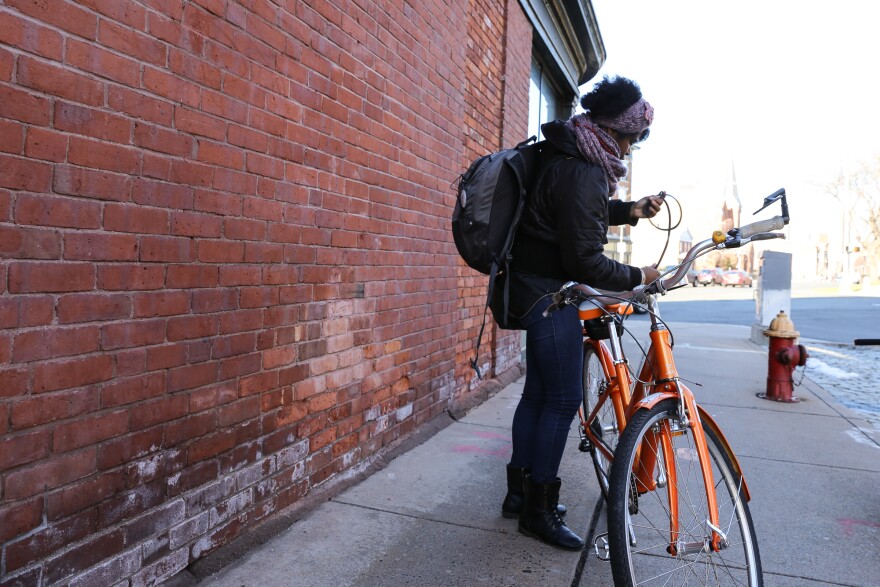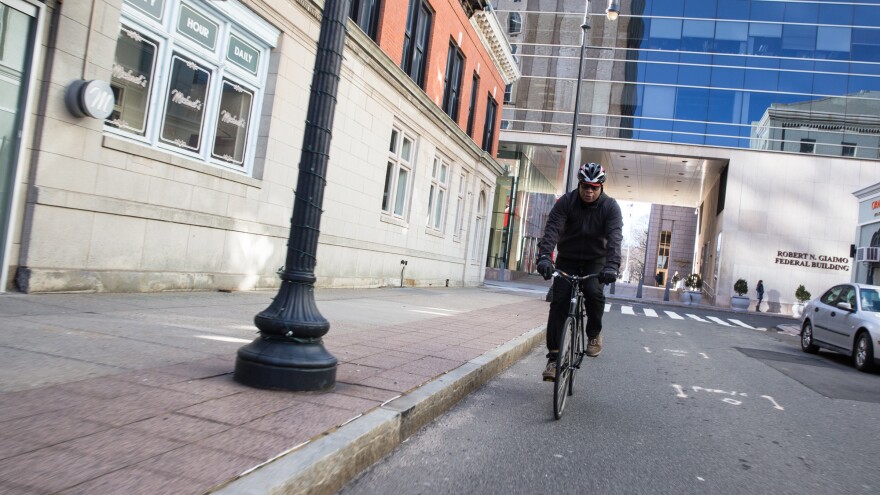Tenaya Taylor says city drivers aren't paying attention to people on bikes.
Hartford resident Tenaya Taylor, 25, became a bike commuter last summer. She’s a college student and works a few different jobs around the city. The bus schedule can be unreliable sometimes, she said, so biking for her is the fastest way to get around.
About a month in, Taylor got hit by a car. She wasn’t hurt too badly -- but she was rear-ended and thrown off her bike.
Taylor is still a year-round bike commuter, though. On the coldest day of the new year, braving the fierce January wind and temperatures below 20 degrees, she was out on her bike getting to work. But she’s sometimes hesitant to ride in the road.
Technically, that’s where cyclists are supposed to ride, but she said traffic is often too dangerous, and drivers aren’t wary of cyclists.
On the Hartford street Taylor rides down in the North End of the city, statistically one of the most dangerous in the state for bikers, she faces potholes, fast traffic, and broken glass -- with no bike lanes to ride in. She said it doesn’t get much easier when she reaches downtown.
“If I’m in downtown Hartford during rush hour, it’s impossible to ride in the street,” Taylor said. “Cars beep at me when they’re behind me, and you’re really not supposed to at cyclists. So there are some challenges trying to be safe and not getting ridden over.”

Halfway through her commute on that cold day in January, Taylor’s bag fell off the back of her bike and her belongings scattered across an intersection on the busy Albany Avenue, but traffic around her didn’t slow when she started to gather her things off the road.
As more states promote cycling as an alternative mode of transportation, there's been an increase in cyclist injuries and fatalities across the nation. Sometimes it's because the cyclists aren't following the rules -- but in her experience, Taylor said it's because drivers aren't paying attention.
Cities across the state still struggle to enforce cycling and traffic rules.
Cycling conditions in Hartford may soon improve for commuters like Taylor. Earlier this year, there was a revision to the city’s zoning regulationsthat introduced guidelines for street design that better accommodate cyclist and pedestrian traffic.
The new zoning policy also includes a map of proposed bike routes in Hartford intended to help the city coordinate bike infrastructure into future repaving and road painting projects.
There’s even some conceptual designs in the works for protected bike lanes -- bike-only paths separate from the road, often with a physical barrier -- which advocates say strongly encourage new cyclists.
Taylor’s route on Albany Avenue, though, could remain without bike lanes for the foreseeable future as the city focuses on other streets.

The commuter cyclist movement has gained momentum state-wide after the new state laws passed last summer, giving engineers more flexibility in designing bike-friendly streets, and people on bikes more flexibility when riding in the road.
A rule that required cyclists to ride “as far to the right as practicable” was eliminated and replaced with language that requires the cyclist to ride as close to the right as is safe, within their own judgment.
But cities across the state still struggle to enforce cycling and traffic rules, and there’s new movement in the state legislature to increase the fine for drivers who fail to yield to cyclists who are legally using the road.
Braving Bad Drivers in Bridgeport
Without the grassroots support of college-fueled bike advocacy campaigns that exist in cities like New Haven and Hartford, Bridgeport faces a steeper climb towards better cycling infrastructure.
Jacob Robison, who works for the city of Bridgeport, said cyclists in the city are often confronted with aggressive drivers. Commuter cycling culture is still new to Bridgeport, “so drivers don’t feel like they have to be respectful to the few cyclists that they do see,” Robison said.

Razul Branch said having a bike can play an important role in the lives of kids living in the city.
So Robison is working with community entrepreneur Razul Branch to get more cyclists on the road, and riding safely.
The cycling co-op they run together, called BikePort, gives bikes to teens and trains them in the rules of the road and bicycle mechanics, a program similar to Hartford's community bike space, BiCi Co. They hope more cyclists on the road will eventually bring more infrastructure to the city.
“We don’t have the infrastructure just yet that Hartford is starting to have, and New Haven has really taken to,” Branch said. “We’re working on trying to improve that.”
Branch, who grew up in Bridgeport, said having a bike can play an important role in the lives of kids living in the city.
“It’s almost kind of one of those things that’s a rite of passage as a kid. Everybody had a bike, or rode a bike, or got a bike,” Branch said.

But the common experience of having a bike doesn’t seem to translate to a more positive driver/biker relationship. In an extreme example, a visit last summer from a BMX stunt cyclist brought a group of over 100 kids on bikes to the streets of Bridgeport -- drawing ire from drivers and residents.
Connecting Race and Ridership in New Haven
Johnny Brehon of New Haven has a much different opinion of city kids on bikes. There’s a group that frequents the bike shop he works at that he admires.
"They call them the wheelie kids 'cause they can pop a wheelie for days. Like yesterday, I saw them," Brehon said, "And I was with another cyclist. I said look at this. I love this."

"Life can be as simple as a bike. We could move forward very efficiently. It doesn’t matter what color you are."
Johnny Brehon
A few years ago, Brehon -- he’s known locally as Johnny B, and sometimes “Mr. Bike” -- rolled his bike into The Devil’s Gear bike shop for the first time. He wanted to see if they would treat him -- an African-American cyclist in an industry that’s predominately white -- like a regular customer.
“And they did,” Brehon said. “They started asking the questions. Not, where you get that bike from? But, what made you build this bike with those components?”
Now Brehon is the shop’s sales manager and an advocate for bringing awareness to cycling as a viable means of transportation.

The City of New Haven is considered a leader in the state for bike-friendliness, with an expanded bike lane network across the city, and plans in the works for two-lane cycle tracks that will be separate from traffic. A 2014 League of American Bicyclists study puts the city fifth in “bike commute cities” in the Eastern U.S., beating out New York City and Boston.
But Brehon said the cycling scene has diversity issues. It’s not that people of color aren’t riding -- they’re just not always represented in cycling advocacy or the cycling industry, he said.
“I think in black and brown communities -- and cycling is actually big in these communities -- when they do a survey, the person giving the survey tends not to go into our communities, unless on the fringe,” Brehon said.
A disconnect between the bike advocacy movement and city bikers can cause a lack of bike infrastructure -- lanes, signs, road paint -- in places that need it the most.
So Brehon is getting the word out.
He’s been attending planning meetings for New Haven’s Bike Month, an awareness campaign that includes several events in different neighborhoods around the city, and sometimes, he rides around town in his race suit simply so people will see him.
“They see me. They see the guys who I ride with too. When they see us, they give you a nod, they honk the horn. They give you the approval,” Brehon said. “And I think most people tend to think that if you’re not from that culture, then you cannot ride through their neighborhood. Actually, you’ll probably be more safe, I think.”
And safety on the road, Brehon said, also comes down to the confidence of the cyclist. He used to be a bicycle messenger back in Baltimore and has worked in the industry for years, so 18-wheelers and speeding traffic doesn’t scare him.
“Whatever lane you’re in, you own the lane.” Brehon said. “That means, when you’re in the street, you’re considered to be a vehicle. So the folks behind you are going to have to wait.”

Brehon stood on the bottom floor of the apartment complex he owns with his wife in the Hill neighborhood of New Haven. He’s been using one room as a place to tinker with his bike collection. Showing off a vintage bike from the 1960s, Brehon said it reminds him of the strife that African-Africans faced during the Civil Rights era.
“Life can be as simple as a bike. We could move forward very efficiently,” Brehon said. “It doesn’t matter what color you are. And cyclists are kind of funny because even if they may be riding a $10,000 bike, when they see someone else with another bike, they may not nod, but they think, yes, that’s a cyclist. He may not have on Spandex, but he has a hard hat and a backpack, and he’s got on construction boots, and he’s going to work. How cool is that?”





